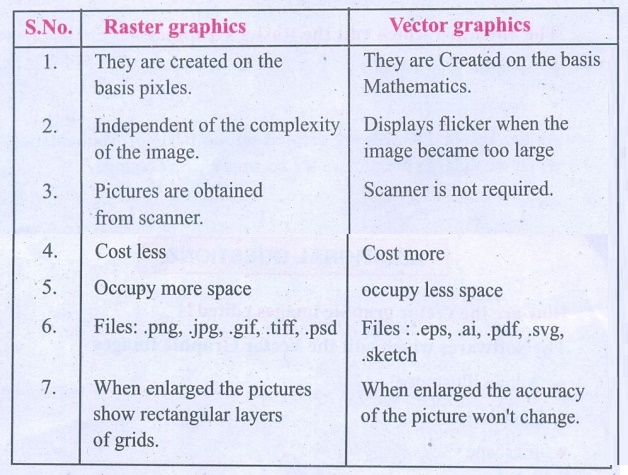Visual Communication | Term 1 Unit 7 | 7th Science - Questions Answers | 7th Science : Term 1 Unit 7 : Visual Communication
Chapter: 7th Science : Term 1 Unit 7 : Visual Communication
Questions Answers
Evaluation
I. Choose the correct answer.
1. Which is the example for an Wimation
?
a.
sound communication
b.
visual communication
c.
vector communication
d.
raster communication
Answer : b. visual communication
2. Who uses the Photoshop
software more ?
a.
Teacher
b.
Doctor
c.
Painter
d.
Photographer
Answer : d. Photographer
3. Which option is used in the
Microsoft Photostory to upload the photos?
a.
Begin a Story
b.
Import Pictures
c.
Settings
d.
View your Story
Answer : b. Import Pictures
4. Which technology shows the
computer-drawn pictures as real picture.
a.
Inkscape
b.
Photo Story
c.
Virtual Reality
d.
Adobe Illustrator
Answer : c) Virtual Reality
5. Which technology uses pixels
to create pictures
a.
Vector
b.
Raster
c.
both
d.
None
Answer : b. Raster
6. Which software is used to
create symbols
a.
Photoshop
b.
Illustrator
c.
Vector Graphics
d.
Photostory
Answer : c. Vector Graphics
II. Match the Following:
1.
Animations - 3D
2.
Raster - Visual Communication
3.
Vector - Pixles
4.
Virtual Reality - Microsoft Photostory
5.
Video Story - Illustrator
Answer:
1. Animations - Visual
Communication
2. Raster - Pixles
3. Vector - Illustrator
4. Virtual Reality -
3 D
5. Video Story - Microsoft
Photostory
III. Answer the following
Questions.
1. What is Raster Graphics?
The picture or image which is created by Raster Graphics is
entered as it is ‘as file and data'. Pictures are of two types one is Vector
another one is Raster.
Raster Graphics are created on the basis of PIXELS. The photos
taken by camera and the photos scanned by a scanner are of the Raster type.
When we enlarge this type of photos we could see the pictures as rectangular
layers or grids.
Raster File Types:
• .png (Portable Network Graphics)
• .jpg or .jpeg (Joint Photographies Experts Group)
• .gif (Graphics interchange Format)
• .tiff (Tagged Image File Format)
• .psd (Photoshop Document)
The Softward which
edit the Raster Graphics:
• Adobe Photoshop
• Vector Graphics
As the Vector Pictures are created on the basis of Mathematics,
even when we enlarge the picture it's accuracy won't change.
Types of Vector
Graphics Files
• .eps (Encapsulated Post Script)
• .ai (Adobe Illustrator Artwork)
• .pdf (Portable Document Format)
• .svg (Scalable Vector Graphics)
• .sketch
2. Write notes on 2D and 3D
pictures
As soon as we see TWO DIMENSIONAL (2D) & THREE DIMENSIONAL
(3D) pictures we know the difference between the two. The two dimensional 2D
images have only the two dimensions - length and height. But three dimensional
images (3D) have length, height and width. 3 D images appear in front of our
eyes like it happens in the real world.
Three dimensional videos will bring the scenes alive before our
eyes. Already there are three dimensional films. Now three dimensional games
have also got released.
Now there is another new technology - VIRTUAL REALITY in 3D.
VIRTUAL REALITY is a technology which shows the computer image as real image.
When we see games through this technology we can fell/perceive the setting of
the game as real. Now this technology has been introduced in Smart Phones too.
3. Differentiate between Raster
and Vector

Raster graphics
1. They are created on the basis pixies.
2. Independent of the complexity of the image.
3. Pictures are obtained from scanner.
4. Cost less
5. Occupy more space
6. Files: .png, .jpg, .gif, .tiff, .psd
7. When enlarged the pictures show rectangular layers of grids.
Vector graphics
1. They are Created
on the basis Mathematics.
2. Displays flicker when the image became too large
3. Scanner is not required.
4. Cost more
5. occupy less space
6. Files : .eps, .ai, .pdf, .svg, .sketch
7. When enlarged the accuracy of the picture won't change.
4. With the help of Microsoft
Photostory how will you create a video on a photostory?
To make videos with the help of this software we have to order
the photos first, then we have select a music and keep in a file.
Step 1: Open the application of' ‘Microsoft Photostory'. In that select
‘Begin A New Story’ and click on
Next.
Step 2 : Click ‘Import Picture’
in the next screen. Now, the files in our computer will appear. Select Saved
pictures for video. There is a provision for editing the picture. If required,
we can edit the image and click on 'Next".
Step 3: Now we can input small text which is apt to the pictures. Then
click on 'Next' and give animation to the vidoes. We can give audio effect also
to these images. After finishing this click on 'Next".
Step 4: To provide background music, we can select a music file through
"Select Music" and click on "Next".
Step 5: Next select a title for the story and select the place where it
has to be saved in your computer. Then, through SETTINGS, change the format of
the video.
Step 6: Now our video is ready to view. Click 'VIEW YOUR STORY'. You
can see your video now.
Related Topics